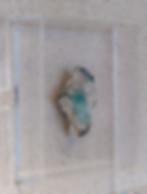

BRAZILIAN NATURAL STONES, DISPLAYED IN SOPHISTICATED ACRYLIC FRAMES. A TRUE WORK OF ART THAT NOT ONLY TRANSFORMS BUT ALSO ENERGIZES THE ENVIRONMENTS OF YOUR HOME.

THE WORLD'S LARGEST CRYSTAL RESERVE IS IN BRAZIL
Brazil ranks at the top globally for precious stones, not only in terms of quantity produced but also due to the wide variety of valuable gems found within its borders. To grasp the scale of Brazil's production, consider that just the state of Minas Gerais accounts for approximately a quarter of all gems extracted worldwide. However, the largest crystal reserve in the world is located in Cristalina, situated 130 km from Brasília, the capital.

AMAZONITE: MYSTERY AND FASCINATION THROUGH THE CENTURIES
The Amazonite takes its name from the Amazon region, more precisely from the Amazon River, due to its captivating blue-green color, although it is not found directly in the area. This crystal is widely known as the 'four-leaf clover of stones,' associated with good luck and fortune. With deep roots in indigenous history and culture, native peoples value amazonite not only for its physical beauty but also for its spiritual and metaphysical properties, used in rituals, ceremonies, and spiritual practices for protection, healing, and spiritual strengthening. The main deposits of amazonite are located in the United States, in Colorado, Brazil, and Madagascar. Historically, it was cherished in ancient Mesopotamia as an adornment for amulets and jewelry, highlighting its fascination and mystique over the centuries.

AQUAMARINE: FROM INDIGENOUS TRADITION TO BRITISH ROYALTY
Brazilian aquamarine is a precious gem deeply rooted in the country's history and culture, owing to its abundant deposits. Since colonial times, this gem has been prized for its beauty and spiritual qualities, used by indigenous peoples to promote tranquility and spiritual protection. In 1980, one of the largest specimens ever found was discovered in the city of Pedra Azul, Minas Gerais, weighing approximately 45 kg and measuring over 0.91 meters in length. This discovery was significant and served as a symbolic homage to the emperors Dom Pedro I and Dom Pedro II, recognizing their historical importance to Brazil. Brazilian aquamarine has also gained international recognition, being gifted to Queen Elizabeth II in 1953 by Brazilian ambassador Assis Chateaubriand to celebrate her coronation. Today, in addition to its unique aesthetic appeal, aquamarine is cherished for its metaphysical properties, including mental clarity, serene communication, and emotional healing, thus perpetuating Brazil's rich tradition in mineralogy and lapidary arts across generations.

CITRINE: BRAZIL'S YELLOW TREASURE
Brazil is one of the world's leading producers of citrine, with significant deposits found in the states of Rio Grande do Sul, Bahia, and Minas Gerais. Particularly in Minas Gerais, it is renowned for producing high-quality citrines valued for their intensely yellow color and exceptional transparency. Historically considered a rare gemstone in Europe, citrine gained popularity after the discovery of its vast reserves in the Americas, becoming accessible in jewelry stores worldwide. However, most commercially available stones are heat-treated amethysts that mimic the characteristics of natural citrine due to its scarcity.

THE WORLD'S LARGEST CRYSTAL
RESERVE IS IN BRAZIL
Brazil stands out as a global leader in quartz crystal production, explored since ancient times due to its extensive deposits. Valued by indigenous peoples for their spiritual significance, quartz crystals were used in rituals to strengthen spiritual connections and provide protection. Today, the country continues to lead the global market with its diverse range of crystals. Cities like Cristalina exemplify this legacy, surrounded by the abundance of the mineral in the subsurface and even on the surface, under a "structural dome" of quartz rocks. Locally, there is a belief that there lies the Earth's balance point, attributed to the magnetism present in the numerous quartz stones.

EXPLORING THE FASCINATING
BRAZILIAN PYRITE
The pyrite, whose name derives from the Greek meaning "fire stone" due to the sparks it emits when struck with steel, is widely known for its resemblance to gold and its symbolic properties. Brazilian pyrite stands out in the market for its intense metallic luster and the formation of well-defined crystals, often cubic, which shine brightly in the light. Often called "fool's gold" due to its visual similarity to gold but significantly lower in value, this designation reflects its brilliant appearance that can deceive the unwary. In various cultures, pyrite is recognized for its mystical and spiritual meanings. It is believed to not only attract wealth and prosperity but also emit positive energy that promotes good luck in business and finance, strengthening personal determination and confidence.

REVELATIONS ABOUT THE TRADITION OF BRAZILIAN AMETHYSTS
Brazil leads globally in amethyst production, renowned for its vast and flawless deposits in the region known as "Ametista do Sul". Found in impressive sizes ranging from 200 to 300 kilograms, amethysts from this area are unmatched in quality and color intensity, surpassing any others found worldwide. For indigenous peoples, amethyst was believed to possess protective powers against negative energies and evil spirits, revered as a sacred stone that strengthened the spiritual connection with ancestors and natural forces. Exported primarily to the United States, Europe, and Asia, these gems are highly prized not only for their exceptional quality but also for their rich cultural and symbolic history.

EXPLORING THE DISTINCTIVE IDENTITY OF BRAZILIAN EMERALDS
Brazilian emeralds are treasures not only for their extraordinary beauty, but also for the deep history they carry. Brazil, as the world's third largest producer, has a mining tradition dating back to pre-colonial times, with records of extraction by indigenous peoples who also valued emeralds for their properties and symbolic meanings. They were often used in religious ceremonies as protective amulets or as part of ritual objects. Some of the largest emeralds ever found, like the iconic "Esmeralda Bahia," currently on display at the American Museum of Natural History in New York, stand out for their impressive size and intense color. With approximately 47% of exports directed to the United States, these gems not only adorn jewelry, but also strengthen a lasting connection between nations, celebrating Brazil's rich mineral and cultural heritage with the world.











